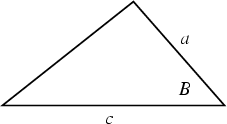|
|
|

Specifying two sides and the Angle between them uniquely determines a Triangle. Let ![]() be the base length and
be the base length and ![]() be the height. Then the Area is
be the height. Then the Area is
| (1) |
| (2) |
| (3) |
 |
(4) | ||
 |
(5) |
See also AAA Theorem, AAS Theorem, ASA Theorem, ASS Theorem, SSS Theorem, Triangle